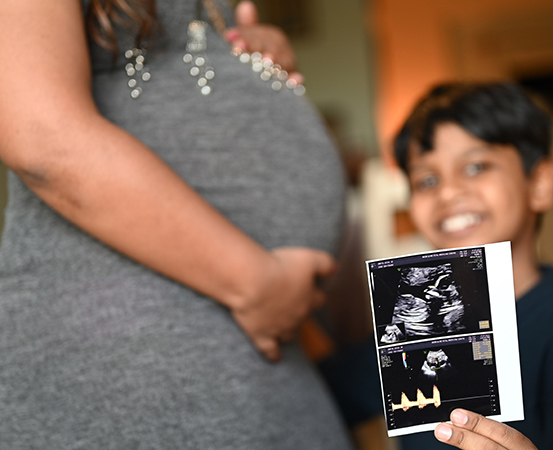
Amniocentesis is a prenatal test that helps to diagnose tentative chromosomal abnormalities, genetic mutations and foetal infections suspected in a foetus based on history, clinical evaluation or other regular antenatal tests.
According to doctors, the results of this test help parents plan on the course of pregnancy.
When should this prenatal test be done?
Amniocentesis is usually carried out between the 15th and 20th week of pregnancy.
“The baby in the foetus is surrounded by amniotic fluid,” Dr Priya Deshpande, consultant at Motherhood Hospitals, Pune, Maharashtra, tells Happiest Health. “This fluid has foetal cells and various proteins. For testing, a small amount of this fluid (20ml) is taken to assess the baby’s health.
“The screening process determines the risk and categorises women in high/low risk through ultrasound examination of the foetus and blood tests like double marker/quadruple/NIPT (non-invasive prenatal test). Those women who are categorised in high risk after screening are advised to undergo amniocentesis.”
Who should undergo amniocentesis test?
According to Dr N Sapna Lulla, lead consultant in obstetrics and gynaecology at Aster CMI Hospital, Bengaluru, the following category of women should undergo amniocentesis:
1. Women whose foetus is at a risk of the following birth defects:
- Brain and spine (neural tube defects) such as spina bifida and anencephaly
- Genetic and chromosomal disorders such as cystic fibrosis, sickle cell disease, Down’s syndrome, Edward’s syndrome (trisomy 18), Tay-Sachs disease and Patau’s syndrome, foetal toxoplasma, cystic fibrosis (also called CF), thalassemia
2. Additionally, the prenatal test is advised for:
- Women who are older than 35 years
- Women who have a family history of genetic condition like cystic fibrosis or Down’s syndrome or abnormal prenatal testing
3. The test is also conducted to check if the:
- Foetus is at risk for Rh disease (also known as haemolytic disease of the foetus and new-born [HDFN] wherein the antibodies in the mother’s blood can destroy the unborn foetus’s blood cells)
- Foetus is highly polyhydramnios (excess amniotic fluid surrounding the foetus)
READ MORE:
Crush Cushing’s syndrome with timely treatment
Why are thyroid disorders common in women?
Preterm labour: signs to watch out for
Why smells can overpower pregnant women
Amniocentesis: accuracy and results
“The accuracy of amniocentesis is 100 per cent for the condition being tested,” says Dr Deshpande. “Hence it is the definitive test.”
The amniocentesis procedure
“A needle is inserted into the uterus to reach the amniotic sac based on ultrasound guidance of the clinician,” says Dr Lulla. “A small amount of amniotic fluid (less than one ounce) is extracted for the test. The aim of this procedure is to check the foetus’ heartbeat. The fluid sample are further assessed wherein the unborn infant’s cells are separated from the amniotic fluid. These are grown for ten to 14 days and checked for birth defects and genetic conditions.”
Precautions while undergoing amniocentesis
“It is normal to feel a slight discomfort with the amniotic fluid aspiration process,” says Dr Deshpande. After the test, doctors say, it is best to:
- Take rest for a few days
- Avoid activities like travel for a few days
Is amniocentesis risky?
Experts say the risk factors associated with the test are minimal. In rare cases, severe complications such as cramping, leaking of amniotic fluid or slight spotting arise. Dr Lulla says that other rare complications include:
- Infection in uterus /infection to the baby or injury to the baby
- Rhythm problems
- Miscarriage (0.1 to 0.3 per cent chance)
The advantages of opting for the procedure are many. “It helps to get essential information about the baby’s health when there are signs of physical abnormalities, chromosomal defects or infection in the baby,” Dr Deshpande says. “This information can help in early diagnosis and management.”















